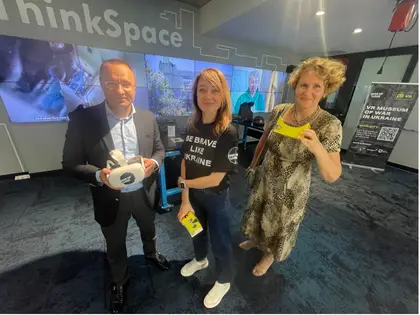The intense impact of Russia’s war on Ukraine has come to Sydney – as well as Bonn, Washington DC, Dubai and Jakarta – through an innovative virtual reality (VR) exhibition.
This week, at Parliament House in Canberra and the Think Space at the University of Sydney, politicians and members of the public got to experience a confronting ‘before and after’ of parts of Ukraine that came under Russian occupation in 2022.
JOIN US ON TELEGRAM
Follow our coverage of the war on the @Kyivpost_official.
Viewers donned 3D goggles and, using AI technology, virtually moved through sites in the Kharkiv, Chernihiv and Kyiv regions and saw the ruination wrought by Russian forces to Ukrainian civilian areas.
The ‘War Up Close’ project, which has now travelled through Europe, North America, the United Arab Emirates, Indonesia, and Australia and is next headed back to the USA, is the brainchild of Oleksii Syvak, a communications expert, and Yuliia Matiash, a digital design expert.
Prior to the full-scale invasion, Matiash and Syvak were collaborating on a Ukrainian tourism promotion using VR, and they had video-recorded extensive digital footage of Ukraine a la Google Streetview.
Following Russian occupation and then Ukrainian liberation of territory in spring 2022, the pair decided the “before” footage could be compared with “after” footage of the devastating scale of Russian destruction. They quickly collected the post-occupation material with the full support of the Ministry of Internal Affairs.

Zelensky Meets CIA Director William Burns in Ukraine
“We started the project because we wanted to show audiences outside Ukraine that the destruction of Ukrainian cities and towns was not random, but the direct result of specific targeting of civilian life by Russian forces,” Syvak said to Kyiv Post. “Plus, it was important to gather evidence for the purposes of war crime prosecution, such as the destruction of cultural sites.”
A viewer with 3D goggles. Photo: Kyiv Post
According to Syvak, the war “has no military objectives, but only the destruction of Ukraine’s culture and identity.” He added that the project needed to move fast to capture the “after” footage because of “Ukrainians’ nature to very quickly clean everything up and restore their lives as fast as possible”.
The curators have now seen thousands of people put on the VR goggles and walk through the digital rubble and broken glass of Ukraine’s churches, schools and museums. That includes “before and after” of the fully-destroyed museum – in a small town in Kharkiv region – to Ukrainian philosopher and musical composer Hryhoriy Skovoroda, who opened the eyes of many 18th century Europeans to Ukrainian culture.
“It’s an awakening for many people,” Sywak said. “Even those who have seen the war on the news – they have seen it through the eyes of a journalist. This technology, on the other hand, enables a person to see themselves among the ruins and the details of the destruction without any filter.
“You can choose to move around and see if you can find a way out. We’ve found that this direct experience has a strong impact on people,” said Syvak.
“It works at an emotional level, but also encourages people to ask themselves: what is my relationship to the destruction I am witnessing?” Syvak explained. “Whether you are a big politician or a student, the exhibition helps people consider their responsibility and role with regard to Russia’s ethnocidal actions against Ukrainians.”
Viewers at exhibition. Photo: Kyiv Post
At the opening of the exhibition in Sydney, Matiash told visitors of her non-virtual and lived experience of the war. With her family and families in nine other cars marked “Children” and under Russian fire, they fled while from enemy occupation of their small town outside Kyiv to Ukrainian lines in March 2022.
“Our lives were so normal and then suddenly they were not. It was important for me to take some of that trauma and do something productive for it for my fellow Ukrainians,” Matiash said.
Those attending the exhibition in Sydney got a sense of that sudden and confronting contrast. Among them were Tayissa O’Keefe, a 17-year-old high school student, and Dr Olga Boichak, a lecturer in digital cultures, who also helped the Embassy of Ukraine to facilitate the exhibition at her university.
“There’s lots of images on social media that are replicated quite easily, but this is an original perspective… These kinds of uncensored, unseen and in-depth images are more powerful,” the student said.
“It’s important to tell the Ukrainian story on every channel. VR is such a rich, immersive media to stimulate the conversation around social responsibility that comes with observing the war in Ukraine…” Boichak said.
“I do think that, because of its immersive nature, this medium makes it more compelling to act. The scale of destruction lends itself to thinking about what can be in those places, what can we do with those spaces to make them beautiful again… It’s really future-oriented.”
Standing quietly and taking in the exhibition was also Tetiana Koldunenko, a local artist who migrated from Ukraine in 2010, who took another and equally poignant view.
“It’s very hard to look at these images. I see streets in Kharkiv that I walked my whole life as a younger person. It feels like my whole childhood has been destroyed,” Koldunenko said.
The exhibition next travels again to Washington DC and the US Congress, where it will be viewed by American lawmakers who decide whether their country continues to soberly support Ukraine’s defense or face away from reality.
You can also highlight the text and press Ctrl + Enter








